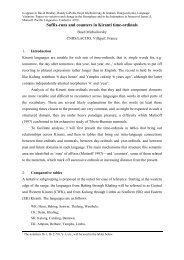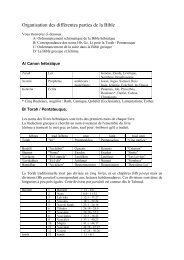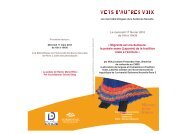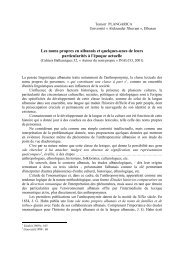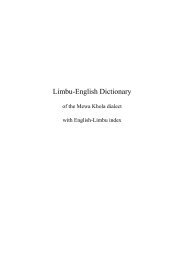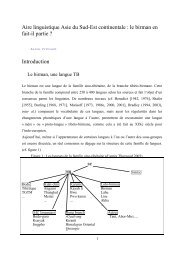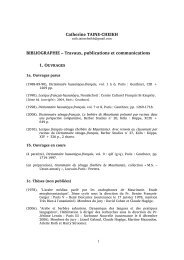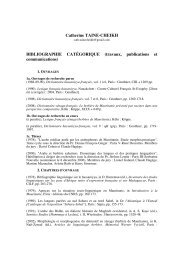Pablo Isaac KIRTCHUK. Date et lieu de naissance ... - Lacito - CNRS
Pablo Isaac KIRTCHUK. Date et lieu de naissance ... - Lacito - CNRS
Pablo Isaac KIRTCHUK. Date et lieu de naissance ... - Lacito - CNRS
- No tags were found...
You also want an ePaper? Increase the reach of your titles
YUMPU automatically turns print PDFs into web optimized ePapers that Google loves.
<strong>Pablo</strong> <strong>KIRTCHUK</strong> Janvier 2011CURRICULUM VITAE <strong>et</strong> LISTE <strong>de</strong>s PUBLICATIONSNom: <strong>Pablo</strong> <strong>Isaac</strong> <strong>KIRTCHUK</strong>.<strong>Date</strong> <strong>et</strong> <strong>lieu</strong> <strong>de</strong> <strong>naissance</strong>: 8 Février 1957 à Córdoba, Argentine.Nationalités : Argentine, Israélienne <strong>et</strong> Française.Situation <strong>de</strong> famille : Marié, 3 enfants.Domicile : 88 rue <strong>de</strong> la Vill<strong>et</strong>te, 75019 Paris, 01.48.03.32.57, kirtchuk@vjf.cnrs.frAffiliation scientifique : LACITO, <strong>CNRS</strong>.DIPLOMESLicence 1983, Université Hébraïque <strong>de</strong> Jérusalem (UHJ), Linguistique Générale, Cumlau<strong>de</strong> & Linguistique Hébraïque, Cum lau<strong>de</strong>.Master 1986, UHJ, Département <strong>de</strong> Langue Hébraïque, Cum lau<strong>de</strong>. Exempté <strong>de</strong>Mémoire après présentation <strong>de</strong> 3 travaux : (1) Les Inscriptions Néo-Puniques <strong>de</strong>Leptis Magna, (2) Les Emprunts Grecs dans un Lectionnaire Syro-PalestinianChrétien, (3) Sur la Prononciation <strong>de</strong>s Mots Hébreux en Judéo-Espagnol.Maîtrise 1987, Université Paris IV, Département d’Espagnol, Option Linguistique.Directeur: B. Pottier. Titre du Mémoire: Santiago <strong>de</strong>l Estero, Argentine: Influencesmutuelles Quichua-Espagnol. Mention : Bien.Doctorat 1993, Université Paris IV-Sorbonne. Directeur : B. Pottier.Titre: Pronoms, Deixis, Accords, Classification: Morphogenèse <strong>et</strong> Fonctionnement.Essai illustré notamment <strong>de</strong> données en Pilagá, Gran-Chaco, Argentine.Très honorable à l’unanimité du jury: Cl. Boisson (Lyon 2, Prési<strong>de</strong>nt), M. Dessaint(Paris IV), Cl. Hagège (Collège <strong>de</strong> France), B. Pottier, <strong>de</strong> l’Institut, Rapporteur.Habilitation à Diriger <strong>de</strong>s Recherches 1994: Départment <strong>de</strong> Sciences du Langage,Université Lumière - Lyon 2. Titre :‘De la pragmatique à l'énonciation, <strong>de</strong> l'énonciation à la morpho-syntaxe, du discours àla grammaire: morphogenèse, grammaticalisation <strong>et</strong> fonctionnement dans le langage.Approche typologique <strong>et</strong> théorique, dans une perspective linguistique générale’.Admis avec les félicitations du jury : Cl. Boisson (Lyon 2), E. Coseriu (Tübingen,Rapporteur), L. Galand (E.P.H.E.), M. Launey (Paris 7), G. Lazard, <strong>de</strong> l’Institut(Prési<strong>de</strong>nt), M. Masson (Paris 3).Autres titres:1984: Certificat d’Allemand, Universtät Bayreuth, Allemagne.1986: Certificat <strong>de</strong> Quichua Universidad Nacional <strong>de</strong> Santiago <strong>de</strong>l Estero, Argentine(UNSE). Summa cum lau<strong>de</strong>.1987: Diplôme <strong>de</strong> l’Ecole Pratique <strong>de</strong> Hautes Etu<strong>de</strong>s, Sorbonne, Paris (IV ème Section:Sciences Historiques <strong>et</strong> Philologiques). Titre du Mémoire : Description phonologique<strong>et</strong> morphologique du parler Quichua <strong>de</strong> Santiago <strong>de</strong>l Estero.1996: CAPES d’Hébreu (Rang : 1). Langue en option : Araméen.1996: Agrégation d’Hébreu (Rang : 1). Langue en option : Judéo-Espagnol.2010: (Re-)Inscrit sur les listes <strong>de</strong> Qualification aux fonctions <strong>de</strong> Professeur <strong>de</strong>sUniversités à la 7 ème (Linguistique <strong>et</strong> Phonétique Générales) <strong>et</strong> à la 15 ème section (LanguesOrientales) <strong>et</strong> aux fonctions <strong>de</strong> MCF à la 14 ème section (Langues Romanes) du CNU.1
EMPLOIS UNIVERSITAIRES ET ASSIMILES:2010- Professeur <strong>de</strong> Néo-Araméen Oriental, INaLCO.1999-2004: Professeur Associé, Département d’Hébreu, Université Ben-Gurion duNéguev, Israël (BGU).1998-1999: Chargé <strong>de</strong> Cours d’Hébreu (Histoire <strong>de</strong> la Langue), Université Paris 8-Vincennes <strong>et</strong> Charles <strong>de</strong> Gaulle-Lille 3.1998: Sollicité par l’Ecole Normale Supérieure comme Professeur d’Hébreu.1997-1999: Directeur Scientifique à l’Union Latine/UNESCO, Paris.1996-1997: Professeur invité, Département d’Hébreu, BGU.1996: Agrégé <strong>de</strong>s Universités titulaire (Hébreu), Ministère <strong>de</strong> l’Education Nationale.1995-1996: Lecteur d’Hébreu, Université <strong>de</strong> Franche-Comté, Besançon, France.1992-1994: ATER, Linguistique Générale, Université Lumière-Lyon 2.1988-1992: Chargé <strong>de</strong> Cours <strong>de</strong> Linguistique & Anglais pour les Sciences du Langage,Université Lumière-Lyon 2.1988-1990: Chargé <strong>de</strong> Cours d’Espagnol, Université Jean-Moulin-Lyon III.1987-1990: Maître <strong>de</strong> Conférences invité, Universidad Nacional <strong>de</strong> Santiago <strong>de</strong>l Estero.1987-1988: Lecteur d’Hébreu, Université Jean-Moulin-Lyon III.1984-1987: Lecteur d’Hébreu, Institut National <strong>de</strong>s Langues <strong>et</strong> Civilisations Orientales,Paris, Université Panthéon-Sorbonne (Paris 1), <strong>et</strong> rédacteur <strong>de</strong> Cours pour la licenced’Hébreu, Centre National d'Enseignement à Distance (CNED), Paris.1982-1983: Enseignant d’Espagnol, Cursos <strong>de</strong> Español, Tel-Aviv.1981-1983: Enseignant d’Hébreu aux Cours d’Eté, UHJ.ACTIVITES PROFESSIONNELLESa) Responsabilités administratives :2002-2004: Directeur <strong>de</strong> la formation en Edition, Département d’Hébreu, BGU.b) Responsabilités extra-Universitaires :1996-1999: Directeur Scientifique à la Direction Terminologie <strong>et</strong> Industries <strong>de</strong> la LangueUNESCO/Union Latine, Paris.c) Conseil Professionnel :1994-1999: UNESCO/Union Latine, en Lexicographie Latino-américaine : Hispanique,Portugugaise <strong>et</strong> Amérindienne.1980: Congrès Juif Mondial (traduction Hébreu-Espagnol).1977: Ministére <strong>de</strong> la Justice, Israël (conseil linguistique <strong>et</strong> traduction Espagnol-Hébreu).d) Comité <strong>de</strong> rédaction <strong>de</strong> revue scientifique1987-1989: Membre du Comité <strong>de</strong> Rédaction d’Amerindia, éds. A.E.A-<strong>CNRS</strong>, Paris.e) Equipes <strong>de</strong> Recherche, Associations Scientifiques <strong>et</strong> Soci<strong>et</strong>és Savantes :2006- : Equipes <strong>de</strong> Recherche ‘Ergativité’ <strong>et</strong> ‘Changements Sémantiques’ <strong>de</strong> laFédération Typologie <strong>et</strong> Universaux Linguistiques, <strong>CNRS</strong>.2002-: CERLITYP (Cercle <strong>de</strong> Recherches en Linguistique <strong>et</strong> Typologie), Paris.2000-: Association <strong>de</strong>s Sciences du Langage, France.1997-: Soci<strong>et</strong>atis Linguisticae Europaeae (Israëlense Sodalicium).1992-: Assises <strong>de</strong> la Traduction Littéraire en Arles (ATLAS).1992-: Association <strong>de</strong>s Traducteurs Littéraires <strong>de</strong> France (ATLF).1987-: Société <strong>de</strong> Linguistique <strong>de</strong> Paris.2
1987-: Asociación Latinoamericana <strong>de</strong> Filología y Lingüística (ALFAL).1987-: Membre fondateur <strong>de</strong> l’équipe argentine <strong>de</strong> Recherche sur la Culture Guaraní.1987-: Membre fondateur du CHACO - Centro <strong>de</strong> Estudios <strong>de</strong>l Hombre AborigenChaqueño (‘Centre d’Etu<strong>de</strong>s sur l’Homme Aborigène du Chaco’), Formosa,Argentine.1986 : CELIA - Centre d'Etu<strong>de</strong> <strong>de</strong>s Langues Indigènes d'Amérique, <strong>CNRS</strong>.1986-: RIVALC - Recherches Interlinguistiques sur les Variations d'Actance <strong>et</strong> leursCorrélats, <strong>CNRS</strong>.1986-: Société <strong>de</strong>s Américanistes <strong>de</strong> Paris.1986-: GLECS - Groupe d’Etu<strong>de</strong>s <strong>de</strong>s Langues Chamito-Sémitiques, Paris.ACTIVITES DANS L’ENSEIGNEMENT UNIVERSITAIRE(a) Enseignement (Echantillon):Master 1 , Département d’Arabe, INaLCO : Néo-Araméen Oriental (Sour<strong>et</strong>h).Licence, Université Lumière-Lyon 2: Introduction à la Linguistique; Morphosyntaxe I <strong>et</strong>II; Langues <strong>et</strong> Cultures Indo-Européennes & Amérindiennes.Licence, Université Jean Moulin-Lyon III: Espagnol.Licence, Université <strong>de</strong> Vicennes-Paris 8: Linguistique hébraïque.Maîtrise & Doctorat, Université Charles <strong>de</strong> Gaulle-Lille 3: Histoire <strong>de</strong> l’Hébreu.Maîtrise & Doctorat, UNSE: Linguistique Générale; Linguistique Amérindienne.Licence, BGU: Morphogenèse <strong>et</strong> Fonctionnement <strong>de</strong>s Classes <strong>de</strong> Mots en Hébreu;Problèmes <strong>de</strong> Morphosyntaxe en Hébreu Contemporain; Textes en HébreuContemporain; Syntaxe <strong>de</strong> l’Hébreu Biblique; Phonologie <strong>de</strong> l’Hébreu Biblique ;Phonologie <strong>de</strong> l’Hébreu Contemporain ; Phonétique Générale.Maîtrise & Doctorat, BGU:Linguistique Hébraïque: L’Hébreu <strong>et</strong> la Typologie Linguistique; Langues ayantinflué sur l’Hébreu: Introduction au Grec, Latin, Allemand <strong>et</strong> Français; DesPropriétés du Langage <strong>et</strong> leur Refl<strong>et</strong>s en Hébreu; Thèmes en LinguistiqueSémitique <strong>et</strong> Générale;Linguistique Générale : Morphogenèse; Parties du Discours <strong>et</strong> Parties <strong>de</strong> la Phrase<strong>de</strong>s Points <strong>de</strong>s Vues Cognitif, Pragmatique <strong>et</strong> Syntaxique; Universaux duLangage; Iconicité; Histoire <strong>de</strong> la Linguistique; Sens <strong>et</strong> Forme dans le Langage;Origine, Nature <strong>et</strong> Caractéristiques du Langage.(b) Thèses <strong>de</strong> DoctoratDirectionEn préparation : R. Skaf, ‘Un morphème relatif, un morphème conjonctif <strong>et</strong> <strong>de</strong>uxprépositions en Syriaque’, Aix-Marseille. Conseiller (directeur Ch. Touratier).2004. Jun Chung Choi: ‘Morphological Adverbs in Biblical Hebrew’. Co-Directeur avecE. Qimron. Dépt. d’Hébreu, BGU.2004. M. Daka. ‘Automatic i<strong>de</strong>ntification of Hebrew and Arabic based on HMM’. Co-Directeur avec A. Cohen, Dépt. <strong>de</strong> Génie Electrique, BGU.Participation à <strong>de</strong>s jurys <strong>de</strong> thèse2009 : Y. Neumann : ‘Influence <strong>de</strong> l’écriture sur la langue’, Paris 3 – Sorbonne Nouvelle.2003. O. Fuchs. ‘Analyse <strong>de</strong> la langue <strong>de</strong>s signes israélienne’. Département <strong>de</strong>Linguistique, BGU.3
2002. K. Il Chung. ‘La grammaire <strong>de</strong> l’ougaritique <strong>et</strong> ses vis-à-vis en Sémitique du Nord-Ouest’. Département d’Hébreu, BGU.2002. S. Boubgar: ‘Description <strong>de</strong> l’Hébreu biblique <strong>et</strong> l’Araméen selon la théoriefonctionnelle d’A. Martin<strong>et</strong>’. Département d’Etu<strong>de</strong>s Hébraïques, Paris 8.2001. I. Dreer: ‘Le subjonctif français: grammaire ou sémantique ?’ Département <strong>de</strong>Linguistique, BGU.2001. D. Amara. ‘Le Grec <strong>de</strong> la Septante <strong>et</strong> l’Araméen du livre <strong>de</strong> Daniel’. Départementd’Etu<strong>de</strong>s Bibliques, BGU.2001. Y. Markus. ‘Dispositifs linguistiques humoristiques dans la prose <strong>de</strong> Benaya-Seri’.Département d’Hébreu, Université Bar-Ilan, Israël.2001. M. Gorlach. 'Les constructions phrastiques <strong>et</strong> la resultativité en Anglais'.Département <strong>de</strong> Linguistique, BGU. Publiée chez Benjamins.BOURSES D’EXCELLENCE, ALLOCATIONS ET MISSIONS DE RECHERCHEBourses:1984: Bourse DAAD pour un cours avancé d’allemand,Universität Bayreuth, Allemagne.1982-4 : Bourse <strong>de</strong> Licence, UHJ.Missions <strong>de</strong> Recherche:1997 : Mission UNESCO/Union Latine Coordination du Lexique Multilingue Espagnol-Quechua-Aymara-Guaraní-Portugais. Recherche bibliographique <strong>et</strong> constitutiond’équipes locales en Equateur, Pérou, Bolivie, Paraguay <strong>et</strong> Argentine.1988, 1990, 1992 : Missions <strong>de</strong> Recherche <strong>CNRS</strong>-CELIA. Suj<strong>et</strong> : La langue Pilagá duGran Chaco, Argentine.1987 : Mission <strong>de</strong> Recherche <strong>CNRS</strong>-CELIA. Suj<strong>et</strong> : Le Quichua <strong>de</strong> Santiago <strong>de</strong>l Estero.1981-1983 : Assistant <strong>de</strong> recherche en Araméen Babylonien, UHJ.RECHERCHE – MOTS CLESAccusativité ; Actance ; Afroasiatique ; Amérindien ; Anaphore = Deixis Intra-Discursive ; Anti-Popper ; araméen ; Autopoièse ; Biologie ; Biphonématicité <strong>de</strong> laRacine Sémitique ; Communication > Catégorisation / Conceptualisation ; CodageMultiple ; Cognition ; Complexité ; Contexte ; Créolistique ; Darwin ; Deixis ;Diachronie ; Dimension Humaine du Langage ; Dynamique ; Echelle d’Empruntabilité ;Epigénie ; Ergativité ; Espagnol ; Evolution ; Expressivité ; Fonction ;Grammaticalisation ; guarani ; hébreu ; Hiérarchisation <strong>de</strong> l’Information ; Hispanique ;Iconicité ; Indo-European ; Intonation ; Lamarck ; ‘Languaging’ ; Maturana (& Varela) ;Nature Interactive du Langage ; Nom ; Non-personne ; Ontogénie ; Origine du Langage ;Paléontologie ; Phylogénie ; Pilagá ; Pragmatique ; Prosodie ; Proto-Sapiens ; quechua ;Réduplication ; Rhématisation ; Scalarité ; Segmentaux, Subsegmentaux &Cosegmentaux ; Sémitique ; Thématisation ; Typologie ; Valence ; Verbe ; [Marquage]Zéro.THEMES DE RECHERCHELangues sémitiques : Hébreu, Araméen ; Proto-sémitique. :Syntaxe (Valence, Actance), Morphologie (Emergence <strong>de</strong> la catégorie verbale),Phonologie (La racine en sémitique, Onomatopée comme une <strong>de</strong>s basesmorpho-sémantiques)4
Langues amérindiennes : Quechua <strong>de</strong> Santiago <strong>de</strong>l Estero (Argentine), Guaraní,Pilagá,SyntaxeOrigine du langage, le Discours comme source <strong>de</strong> la Grammaire,L’Interaction comme source du discours,PROGRAMME DE RECHERCHELivre en cours <strong>de</strong> rédaction : LUIT: Language – a Unified and Integrative Theory.Fédération Typologie <strong>et</strong> Universaux du LangageHiérarchisation (‘structruration’) <strong>de</strong> l’Information, dir. M.M. J. Fernán<strong>de</strong>z-VestInternal Hierarchy of the Utterance (‘Information Structure’)dir. M.M. J. Fernán<strong>de</strong>z-VestCONFERENCES(a) Conférences plénières invitées2011 : Colloque L’Interlocution comme paramètre : nouvelles données/nouveaux modèles,Amiens. ‘G comme Géo- ou Grammato-centrique à H comme Hélio- ou Humanocentrique: L’interlocution, source pérenne du langage’2004 : Université <strong>de</strong> Tel Aviv, ceremonie in memoriam R. Malis Treister. Titre :Idiomas <strong>de</strong> Hispanoamérica: Lengua e I<strong>de</strong>ntidad.2000: VI o Congrès International <strong>de</strong> Quechua, Santiago <strong>de</strong>l Estero, Argentina. Titre:Propuesta para una ortografía normalizada <strong>de</strong>l Quichua santiagueño.(b) Conférences à <strong>de</strong>s congrès internationaux2011 16th Symposium on Latin Linguistics, Uppsala. ‘The importance of the Punicpassages in Plautus’ Poenulus for Semitic and General Linguistics’.2010 : Information Structure aqnd Typlology Sympopsium, Paris. ‘Internal Hierarchy of theUtterance (IHU) in the Context of Language as a Biological Device2010 : Symposium on Prolepsis, Liège Titre : ‘Leaving Prolepsis: Pragmatic, Prosodic,Typological, Dynamical and Biological Consi<strong>de</strong>rations’..Symposium Grammaire <strong>de</strong> l'information <strong>et</strong> Typologie - Information Grammar andTypology, Paris. Titre: ‘Topic-first utterances in Hebrew and beyond : dynamicalconsi<strong>de</strong>rations’2009 : The Conference on Verb Typology, Ghent. Titre : The Verb as a Construct.Observations and Consequences.2007.The 7th Conference of the Association of Lingiuistic Typology, Paris 2007. Titre:‘A typologically composite, second-or<strong>de</strong>r and non-universal category: Synchronic,diachronic, ontogen<strong>et</strong>ic and phylogen<strong>et</strong>ic reflections on the Verb’.2004: Colloque ‘Deixis : From Utterance to Uttering and Vice-Versa, Tartu, Estonie.Titre: Deixis as the origin of language.2004: 32 th North American Conference on Afro-Asiatic Linguistics, San Diego. Titre:Hebrew as a test-case for the biphonematism of the Semitic root.2004: International Language and Cognition Conference, Coffs Harbour, Australia. Titre:Deixis and Cognition.5
2004: TYPO 4, Paris. Titre: Interrogation > Exclamation > Négation.2003: 17 ème Congrès International <strong>de</strong>s Linguistes. Titre:For a Copernican revolution in Linguistics.2003: Iconicity in Language and Literature, Louvain la Neuve. Titre:What iconicity tells us about language’s origin and structure2002: TYPO 3, Paris. Titre: Thématisation? Dislocation? Réfutation <strong>de</strong> l’approche reçue.2001: Atelier International en Linguistique in memoriam H.J. Polotsky, AcadémieNationale <strong>de</strong>s Sciences, Jérusalem. Titre: Language: A Typological, Functional,Cognitive, Biological and Evolutionary Approach.2000: 16 ème Colloque du Soci<strong>et</strong>atis Linguisticae Europaeae Sodalicium Israelense. Titre:'al ha'ikoniut ve-kama mi-giluyyeyha be'ivrit ('L’iconicité <strong>et</strong> ses manifestations enHébreu').1999: The Conference on Hebrew as a Living Language, Oranim, Israel. Titre: sugiyyotb e targum: miqre prati w e haHlaxot klaliyyot (‘Problèmes <strong>de</strong> traduction: un casparticulier <strong>et</strong> <strong>de</strong>s consi<strong>de</strong>rations générales').1999: 3 rd International Congress on the Hebrew of The Dead sea Scrolls and Ben Sira,Beer Sheva. Titre: Some Cognitive and Typological Semantic Remarks on theLanguage of the Dead Sea Scrolls.1997: 13 ème Colloque du Soci<strong>et</strong>atis Linguisticae Europaeae Sodalicium Israelense. Titre:r e miza umijjun shemani b e pilagá. (‘Deixis <strong>et</strong> classes nominales en Pilagá’).1993: Présentation au Colloque Franco-Allemand « Syntaxe structurale <strong>et</strong> opérationsmentales », Strasbourg. Titre: Deixis <strong>et</strong> actance: du cognitif au syntaxique enlinguistique générale.1993: Conférence au IV ème Symposium International <strong>de</strong> Linguistique Hispanique,Leipzig. Titre: La naturaleza <strong>de</strong>l verbo: Aspectos lingüísticos y cognitivos.1992: Colloque « Les Parties du Discours », Lyon. Titres:(1) Les problématiques <strong>de</strong>s parties du Discours, en collaboration avec L. Bass<strong>et</strong> <strong>et</strong>Cl. Boisson; (2) Deixis, anaphore, ‘pronoms’: morphogenèse <strong>et</strong> fonctionnement.1992: Colloque Lucien Tesnière aujourd'hui, Rouen. Titre: Actants Y atypiques.1990: GLECS, Paris. Titre: Tamyiz <strong>et</strong> état construit en Sémitique.1988: Séminaire DEA du LACITO, <strong>CNRS</strong>, Paris. Titre: Les langues Amérindiennes <strong>et</strong> lalinguistique comparative.1988: Colloque: Les Déterminations du nom. LACITO, <strong>CNRS</strong>, Paris. Titre:Etat-construit vs. Tamyiz: <strong>de</strong> la détermination du nom en Sémitique .1987: VIII th Congrès <strong>de</strong> la Asociacion Latinoamericana <strong>de</strong> Filologia y Linguistica(ALFAL), Tucumán, Argentine. Titre: Estructuras actanciales en Quechua.1987: Colloque « Linguistique en Sorbonne » sur le Mot. Titre: Le Mot en Sémitique(d) Présentations à <strong>de</strong>s Séminaires Universitaires2010. Aix-Marseille. Titre : ‘LUIT – Language, a Unified and Integrative Theory’.2009. Aix-Marseille. ‘A la recherche du TAM perdu… en Hébreu Biblique’.2007: EHESS / IHEAL. Titre : 'Au suj<strong>et</strong> <strong>de</strong> la traduction radicale: le langage <strong>et</strong> l’humour'.2005: Ecole Biblique <strong>et</strong> Archéologique Française <strong>de</strong> Jérusalem. Titre:Le bi-phonématisme <strong>de</strong> la racine Sémitique.2003: Département d’Hébreu, BGU. Titre: limmud ha’ibrit umexqarah bama’arab bimeyhabeynaim, harenesans w e ha’<strong>et</strong> haxadasha (Recherche <strong>et</strong> Enseignement <strong>de</strong>l’Hébreu en Occi<strong>de</strong>nt au Moyen-Age, à la Re<strong>naissance</strong> <strong>et</strong> aux Temps Mo<strong>de</strong>rnes).6
2002: Département d’Hébreu <strong>et</strong> langues Sémitiques, Université <strong>de</strong> Tel Aviv. Titre: ?<strong>et</strong> -gisha xadasha (/'<strong>et</strong>/ en Hébreu Biblique – une nouvelle approche).2002: Département <strong>de</strong> Linguistique, UHJ. Titre: ‘al ha?ikoniut w e kama miggiluyyeyhab e ’ibrit (L’iconicité <strong>et</strong> ses manifestations en Hébreu).1999: Département <strong>de</strong> Traduction <strong>et</strong> Interprétariat, Université Bar-Ilan, Israël. Titre:‘al tirgum shira bixlal umisfaradit bifrat (Sur la traduction <strong>de</strong> poésie en général <strong>et</strong><strong>de</strong> l’espagnol en particulier).1996: Département <strong>de</strong> Littératures Etrangères <strong>et</strong> Linguistique, BGU. Titre: Deixis.LISTE <strong>de</strong>s TRAVAUXPUBLICATIONS SCIENTIFIQUESI. PUBLICATIONS SCIENTIFIQUES REFEREES(a) Thèse disponible à l’ANRT, Lille1. Kirtchuk P. 1993. Deixis, anaphore, accords, classification: morphogenèse <strong>et</strong>fonctionnement.. Essai illustré notamment <strong>de</strong> données en Pilagá (Gran Chaco,Argentine) ISSN 0294-1767, n° 0347.15273/93, ANRT, Lille, 257 pp.(b) Direction <strong>de</strong> Volumes Collectifs2. Kirtchuk P. (ed.) 1999. Léxico Multilingüe Español-Quechua-Aymara-GuaraníPortugués. 10000 termes en Biodiversité, Nutrition <strong>et</strong> Santé. DTIL, Union Latine /UNESCO, Paris. CD-ROM.3. D. Sivan & Kirtchuk, P. & (eds.). 2003 Festschrift Ben-Tolila (en Hébreu). BGUEditions, 400 pp.(c) Chapitres / Articles d’Ouvrages Collectifs, Actes <strong>de</strong> Colloques, Festschrifte, &c.4. Kirtchuk P. 1989. Estructuras actanciales en Quechua Actas <strong>de</strong>l VIII o Congreso <strong>de</strong> laAsociación Latinoamericana <strong>de</strong> Filología y Lingüística” (ALFAL). Ediciones UNT,Tucumán (Argentina),139-140.5. Kirtchuk P. 1994. La naturaleza <strong>de</strong>l verbo: Aspectos lingüísticos y cognitivos. Actas<strong>de</strong>l IV o Coloquio Internacional <strong>de</strong> Lingüística Hispánica (Leipzig 1993). Verbo eEstruturas Frásicas, Faculda<strong>de</strong> <strong>de</strong> L<strong>et</strong>ras do Porto, Portugal, 33-43.6. Kirtchuk P. 1994. Deixis, anaphore, « pronoms »: morphogenèse <strong>et</strong> fonctionnement.Les Classes <strong>de</strong> mots. L. BASSET <strong>et</strong> M. PERENNEC (eds.). Presses Universitaires <strong>de</strong>Lyon (P.U.L.), 169-205.7. Kirtchuk P. 1995. Renouvellement grammatical, renouvellement lexical <strong>et</strong>renouvellement conceptuel en Sémitique. Autour <strong>de</strong> la dénomination. PressesUniversitaires <strong>de</strong> Lyon (Cl. Boisson & Ph. Thoiron, dirs.), 175-213.8. Kirtchuk P. 1995. Actants Y atypiques. Actes du Colloque Lucien TESNIEREaujourd'hui, Mont-Saint-Aignan 1992, Paris, Pe<strong>et</strong>ers, 302-306.9. Kirtchuk P. 1995. Deixis <strong>et</strong> actance: du cognitif au syntaxique en linguistique générale.Actes du Colloque Franco-Allemand Syntaxe structurale <strong>et</strong> opérations mentales(Strasbourg 1993): Linguistische Arbeiten. Max Niemeyer Verlag, Tübingen, 137-150.10. C. Boisson, Kirtchuk P. & L. Bass<strong>et</strong>. 1995. Les problématiques <strong>de</strong>s parties dudiscours. Les Classes <strong>de</strong> mots. L. BASSET <strong>et</strong> M. PERENNEC (éds.). P.U.L., 1-25.7
11. Kirtchuk P. 1996. Lingüística areal: <strong>de</strong>ixis y clasificación nominal <strong>de</strong>l Gran Chaco. In:H.E. Martín & A. Pérz Diez (eds.), Lenguas indígenas <strong>de</strong> Argentina 1492-1992: 73-84.San Juan: Instituto <strong>de</strong> Investigaciones Lingüísticas y Filológicas “Manuel Alvar”,Universidad Nacional <strong>de</strong> San Juan, Argentina.12. Kirtchuk P. 1998. sh e 'ela, qri'a, shlila: magga’im ("Interrogation, Exclamation <strong>et</strong>Négation: Rapports", en Hébreu). shay laHadassa, BGU Editions, 263-272.13. Kirtchuk P. 1998. r e miza umijjun shemani b e pilagá. Actes <strong>de</strong> la 13 e réunion annuelledu Soci<strong>et</strong>atis Linguisticae Europaeae Sodalicium Israëlense (1996), Jérusalem, 37-45.14. Kirtchuk P. 2000. Some Cognitive and Typological Remarks on the Hebrew of theDead Sea Scrolls. Diggers at the Well, Proceedings of a Third International Congress onthe Hebrew of The Dead Sea Scrolls and Ben Sira, T. Muraoka & J.F. Elwol<strong>de</strong> (eds.).Brill, Amsterdam,131-136.15. Kirtchuk P. 2000. Deixis and Noun Classification in Pilagá and Beyond. B<strong>et</strong>weenGrammar and Lexicon, E. Contini Morava & Y. Tobin (eds.), John Benjamins,Amsterdam/ Phila<strong>de</strong>lphia, 31-55.16. Kirtchuk P. 2001. ‘al ha?ikoniut w e kama migiluyyeyha b e ’ibrit ('Sur l’iconicité <strong>et</strong> sesmanifestations en Hébreu'). Actes <strong>de</strong> la 16 th réunion du Soci<strong>et</strong>atis Linguisticae EuropaeaeSodalicium Israëlense. Beer Sheva, BGU Editions, 8-27.17. Kirtchuk, P. 2002. The Hebrew Language. Oxford Handbook of Jewish Studies.Oxford University Press, 492-514.18. Kirtchuk, P. 2003. sugiyyot b e targum: miqre prati w e hashlakot klaliyyot ('Problèmes<strong>de</strong> la traduction: un cas particulier <strong>et</strong> <strong>de</strong>s considérations générales’). Festschrift BenTolila, BGU Editions, 145-150.19. Kirtchuk, P. 2004. Deixis vs. conceptualization, discourse vs. grammar, parole vs.langue: the Copernican revolution in linguistics. 12 pp.Actes du 17 ème Congrès International <strong>de</strong>s Linguistes, Prague, 2003 (CD-ROM).20. Kirtchuk, P. 2004. Quechua. Les Mots Composés: données en 16 langues. P. Arnaud(ed.). Presses Universitaires <strong>de</strong> Lyon.21. Kirtchuk, P. 2005. Definiteness, 3 pp. Encyclopedia of Linguistics. NY: Routledge.22. Kirtchuk, P. 2005. Some Iconic Correlations in Language and their Impact on theParole-Langue Dichotomy. Outsi<strong>de</strong>-In — Insi<strong>de</strong>-Out: Iconicity in Language andLiterature 4. Mae<strong>de</strong>r, C., O. Fischer & W. J. Herlofsky (eds.) John Benjamins,Amsterdam-Phila<strong>de</strong>lphia : 267-286.23. Kirtchuk, P. Deixis as The Origin of Language. Proceedings of the Conference‘Deixis : ‘From Utterance to Uttering and Vice-Versa’, Tartu 2004.24. Kirtchuk, P. 2005. Thématisation? Dislocation? Réfutation <strong>de</strong> l’approche reçue.Linguistique Typologique, Moyse-Faurie C. & G. Lazard (dirs.) Lille, 109-122.25. Kirtchuk, P. 2007. The 7th Conference of the Association of Linguistic Typology,Paris 2007. Title: A typologically composite, second-or<strong>de</strong>r and non-universal category:Synchronic, diachronic, ontogen<strong>et</strong>ic and phylogen<strong>et</strong>ic reflections on the Verb. Livre <strong>de</strong>sRésumés <strong>de</strong>s Communications au colloque26. Kirtchuk, P. 2007. LUIT: Language - a Unified and Integrative Theory. Combat pourles langues du mon<strong>de</strong> – Fighting for the World’s Languages : Hommage à Clau<strong>de</strong>Hagège, M.-M. Jocelyne Fernan<strong>de</strong>z-Vest (dir.) pp. 271-282. Paris, L’Harmattan.8
27. Kirtchuk, P. Language: A Typological, Functional, Cognitive, Biological andEvolutionary Approach. Proceedings of the International Workshop in memory of H. J.Polotsky, Israël National Aca<strong>de</strong>my of Sciences. Jérusalem 2001.28. s.p. Kirtchuk, P. ‘Origo <strong>de</strong>s Zeigfelds = Origo <strong>de</strong>r Sprache : Karl Bühler commeprécurseur à son corps <strong>de</strong>fendant <strong>de</strong> l’approche évolutionniste du langage’. Actes du XIColloquium on the History of Language Sciences, Potsdam 2008.(d) Articles dans <strong>de</strong>s Revues Scientifiques Réferencées29. Kirtchuk P. 1987. Structures actancielles en Quechua.Actances 3: 159-177. Paris, RIVALC-<strong>CNRS</strong>.30. Kirtchuk P. 1987. Le parler Quichua <strong>de</strong> Santiago <strong>de</strong>l Estero: quelques particularités.Amerindia 12: 95-110. Paris. A. E. A.-<strong>CNRS</strong>.31. Kirtchuk P. 1989. Classes <strong>de</strong> Verbes en Hébreu Biblique <strong>et</strong> Contemporain: Etu<strong>de</strong>morphosyntaxique <strong>et</strong> sémantique. Actances 4: 137-173. Paris. RIVALC-<strong>CNRS</strong>.32. Liuzzi S. & P. Kirtchuk.1989. Tiempo y aspecto en Guaraní. Amerindia 14: 9-12.Paris. A. E. A.-<strong>CNRS</strong>. 199 pp.33. Boisson Cl., P. Kirtchuk & H. Béjoint. 1991. Aux origines <strong>de</strong> la lexicographie: lespremiers dictionnaires monolingues <strong>et</strong> bilingues.International Journal of Lexicography 4-4: 261-315. Oxford University Press.34. Kirtchuk P. 1992. A l'intersection <strong>de</strong> la <strong>de</strong>ixis <strong>et</strong> l'actance: l'orientation du procès enQuechua. Modèles linguistiques XIV. fasc. 28: 141-153. ANRT, Lille35. Kirtchuk P. 1993. Souvenirs d'un traducteur. TransLittérature 5: 34. Paris-ATLF.36. Kirtchuk P. 1993. /'<strong>et</strong>/ ou ne pas /'<strong>et</strong>/: l'actant Y en Hébreu biblique <strong>et</strong> au-<strong>de</strong>là.Actances 7: 91-137, Paris, RIVALC-<strong>CNRS</strong>.37. Kirtchuk P. 1997. Remarques sur le Mot dans quelques langues Sémitiques. GLECS32: 33-54, Paris, Langues O’.38. Kirtchuk, P. 2005. maxl e qot p e ’alim ' a xadot b e -‘ibrit: t e cura, ‘erkiyyut, diateza, aspekt,semantika, pragmatika (‘Quelques classes <strong>de</strong> verbes in Hébreu: Morphologie, Valence,Diathèse, Aspect, Sémantique, Pragmatique’, en Hébreu) L e shonenu 347-365.I’ RECHERCHE EN COURSArticles sous presse ou en cours <strong>de</strong> rédaction39. Kirtchuk, P. Hebrew as a Case-Test for the 2-Phoneme Root in Semitic. Proceedingsof the 32 th annual Me<strong>et</strong>ing of the North American Conference on Afro-Asiatic Linguistics(NACAL), San Diego 2004.40. Kirtchuk, P. ‘Leaving Prolepsis: Pragmatic, Prosodic, Typological, Dynamical andBiological Consi<strong>de</strong>rations’. Symposium on Prolepsis, Liège 2010.41. Kirtchuk, P. ‘Interrogation > Exclamation > Négation’. Ms.42. Kirtchuk, P.Ethnotextes en Quichua <strong>de</strong> Santiago <strong>de</strong>l Estero (Argentine). Ms.43. Kirtchuk, P. ‘Ergative features in North-Eastern Neo-Aramaic (NENA)’.44. Kirtchuk, P. ‘Onomatopoeia in Hebrew’, ‘Hebrew and Typology’, ‘Hebrew andGeneral Linguistics’, ‘Equative Sentences in Biblical Hebrew’, ‘Hebrew in theUniversities’, à p. dans Encyclopedia of Hebrew Language and Linguistics, Brill 2011.45. Kirtchuk, P. ‘Aspect as the source of diathesis’, à p. dans Papers on TAM, Z.Guentchéva (ed.).9
46. Kirtchuk, P. ‘The importance of the Punic passages in Plautus’ Poenulus for Semiticand General Linguistics’. 16th Symposium on Latin Linguistics, Uppsala 2011.47. Kirtchuk, P. ‘Hiérarchisation <strong>de</strong> l’Information en Hébreu’. Proj<strong>et</strong> Structure <strong>de</strong>l’Information, Fédération Universaux <strong>et</strong> Typologiue linguistique, <strong>CNRS</strong>.48. Kirtchuk, P. ‘G comme Géo- ou Grammato-centrique à H comme Hélio- ou Humanocentrique: L’interlocution, source pérenne du langage’ Actes du Colloque L’Interlocutioncomme paramètre : nouvelles données/nouveaux modèles,, Amiens 2010.49. Kirtchuk, P. ‘The importance of the Punic passages in Plautus’ Poenulus for Semiticand General Linguistics’. 16th Symposium on Latin Linguistics, Uppsala.50 : Kirtchuk, P. ‘Leaving Prolepsis: Pragmatic, Prosodic, Typological, Dynamical andBiological Consi<strong>de</strong>rations’.. Lingua Latina 2011.51. Kirtchuk, P. ‘Internal Hierarchy of the Utterance (IHU) in the Context of Language as aBiological Device. Symposium Information Structure & Typology. Paris.Livre en cours <strong>de</strong> rédaction52. Kirtchuk, P. LUIT: Language – a Unified and Integrative Theory. Lincom Europa,Munich.II. AUTRES PUBLICATIONS SCIENTIFIQUES(a) Comptes Rendus <strong>et</strong> Articles Critiques dans <strong>de</strong>s Revues Scientifiques Référencées1. 1988: Michel MASSON-Langue <strong>et</strong> Idéologie. Les mots nouveaux en Hébreu mo<strong>de</strong>rne,Eds. du <strong>CNRS</strong>. Paris 1986, 294 pp. Bull<strong>et</strong>in <strong>de</strong> la Société <strong>de</strong> Linguistique <strong>de</strong> Paris(BSL) 83-2: 288-291. Paris, Klincksieck.2. 1990: Mary RITCHIE KEY & Henry H. HOENIGSWALD (eds.)-Studies in Generaland Amerindian Ethnolinguistics. Mouton <strong>de</strong> Gruyter. New York-Berlin 1989, 499pp. BSL 85-2: 380-393.3. 1991: Giancarlo M. G. SCODITTI-KITAWA. A Linguistic and Aesth<strong>et</strong>ic Analysis ofVisual Art in Melanesia. Mouton <strong>de</strong> Gruyter, Berlin-New York 1989, 457 pp. BSL86-2: 300-302.4. William BRIGHT (volume editor)-The Collected Works of Edward Sapir, Volume V:American Indian Languages. Mouton <strong>de</strong> Gruyter. Berlin-New York 1990, 584 pp.BSL 86-2: 302-317.5. Desmond C. DERBYSHIRE & Geoffrey K. PULLUM (eds.) Handbook of AmazonianLanguages vol. 2. Mouton <strong>de</strong> Gruyter, Berlin-New York 1990. 474 pp. BSL 86-2:317-320.6. Keren RICE-A Grammar of Slave. Mouton <strong>de</strong> Gruyter, Berlin-New-York 1989, 1370pp. BSL 86-2: 320-322.7. Eung-Do COOK and Keren D. RICE (eds.)-Athapaskan Linguistics: CurrentPerspectives on a Language Family (Trends in Linguistics State-of-the-Art Reports15). Mouton <strong>de</strong> Gruyter. Berlin-New York 1989. 645 pp. BSL 86-2: 322-327.8. 1992: Maria-Elisab<strong>et</strong>h CONTE, Anna GIACALONE RAMAT, Paolo RAMAT,(eds.)-Dimensioni <strong>de</strong>lla linguistica [Materiali Linguistici l]-Università <strong>de</strong> Pavia).Milano, Franco Agneli 1990, 239 pp. BSL 87-2: 35-44.9. Carl VETTERS and Willy VANDEWEGHE (eds.)-Perspectives on Aspect andAktionsart. Belgian Journal ot Linguistics 6, 1991. Editions <strong>de</strong> l'Université <strong>de</strong>Bruxelles. 180 pp. BSL 87-2: 70-73.10
10. Revue Roumaine <strong>de</strong> Linguistique Tome XXXV (fasc. 1-6), 1990. Bucuresti. 396 pp.BSL 87-2: 109- 116.11. Linguisticae Investigationes. Revue internationale <strong>de</strong> linguistique Française <strong>et</strong> <strong>de</strong>linguistique générale Tome XIV. 1990. Fascicule 1. Amsterdam-Phila<strong>de</strong>lphia. JohnBenjamins. 168 pp. BSL 87-2: 118-11912. M.-A. MOREL & L. DANON-BOILEAU (dirs.)-La <strong>de</strong>ixis, Paris 1992, 664 pp.Cahiers <strong>de</strong> linguistique praxématique 19: 168-169. Montpellier. PRAXILING.13. 1993: Linguisticae Investigationes. Revue internationale <strong>de</strong> linguistique Française <strong>et</strong><strong>de</strong> linguistique générale, Tome XV. 1991 Fascicule l, Amsterdam-Phila<strong>de</strong>lphia. JohnBenjamins. 168 pp. BSL 88-2: 14-18.14. Philip BALDI (ed.)-Patterns of change, Change of Patterns. Linguistic Change andReconstruction M<strong>et</strong>hodology. Mouton <strong>de</strong> Gruyter, Berlin-New York. 1991. 343 pp.BSL 88-2: 53-61.15. Michael CLYNE (ed.)-Pluricentric Languages. Differing Norms in Different Nations.Mouton <strong>de</strong> Gruyter. Berlin-New York, 1992, 481 pp. BSL 88-2: 83-91.16. Frans PLANK (ed.)-Paradigms. The Economy of Inflection. Mouton <strong>de</strong> Gruyter.Berlin-New York, 1991. 313 pp. BSL 88-2: 108-113.17. Florian COULMAS (ed.)-A Language Policy for the European Community.Prospects and Quandaries. Mouton <strong>de</strong> Gruyter; Berlin-New York. 1991, 311 pp.BSL 88-2: 300-305.18. Jean-Louis VINAY-Carn<strong>et</strong> <strong>de</strong> notes montagnais-naskepi 1947-1992. Agnew-Laplante, Sidney, Canada. 1992. 239 pp. BSL 88-2: 361-362.19. Jacques MAURAIS (dir.)-Les langues autochtones du Québec. Conseil <strong>de</strong> la langueFrançaise. Les Publications du Québec. Québec 1992, 455 pp. BSL 88-2: 357-362.20. Reineke BOK-BENNEMA-Agreement and case in inuit. Studies in generativegrammar 38. Foris. Amsterdam-New York. 1992. 307 pp. BSL 88-2: 362-36421. 1994: P. H. MATTHEWS-Grammatical Theory in the United States from Bloomfieldto Chomsky. Cambridge Studies in Linguistics 67. Cambridge University Press.1993. 272 pp. BSL 89-2: 22-2622. Vincent J. van HEUVEN & Louis C. W. POLS (eds.)-Analysis and Synthesis ofSpeech. Strategic Research towards High-Quality Text-to-Speech Generation.Mouton <strong>de</strong> Gruyter. Berlin-New York 1993. 212 pp. BSL 89-2:129-132.23. Elaine F. NARDOCCHIO (ed.)-Rea<strong>de</strong>r's Response to Literature. The EmpiricalDimension. Mouton <strong>de</strong> Gruyter, Berlin-New York 1992, 313 pp. BSL 89-2: 151-153.24. Jack SCHMIDELY-Etu<strong>de</strong>s <strong>de</strong> morphosyntaxe Espagnole. Les cahiers du CRIAR n°13. Publications <strong>de</strong> l'Université <strong>de</strong> Rouen. 1993. 185 pp. BSL 89-2: 269-273.25. Ana ROCA & John M. LIPSKI (eds.)-Spanish in the United States. LinguisticContact and Diversity. Mouton <strong>de</strong> Gruyter, Berlin-New York 1993. 2 12 pp. BSL89-2. pp. 273-277.26. 1995: Bol<strong>et</strong>ín <strong>de</strong> filología Tomo XXXIII. Facultad <strong>de</strong> Filosofía y Humanida<strong>de</strong>s,Departamento <strong>de</strong> Lingüística. Universidad <strong>de</strong> Chile, 1992, 311 pp. BSL 90-2:21-26.27. Cua<strong>de</strong>rnos <strong>de</strong> investigación filológica, Tomo XVIII, Fasc. I y 2. Publicaciones <strong>de</strong> laUniversidad <strong>de</strong> La Rioja. Logroño. 1992. 204 pp., BSL 90-2:26-28.28. Verba. Anuario galego <strong>de</strong> filoloxía, vol. 20. Universida<strong>de</strong> <strong>de</strong> Santiago <strong>de</strong> Compostela,1993. 509 pp. BSL 90-2:28-33.11
48. Pierre ATTAL-Questions <strong>de</strong> sémantique. Une approche comportementaliste dulangage, Pe<strong>et</strong>ers, Louvain-Paris 1994, 319 pp. BSL 92-2:90-91.49. Anna GIACALONE RAMAT/Grazia CROCCO GALEAS (eds.)-From Pragmaticsto Syntax. Modality in Second Language Acquisition. Gunter Narr Verlag, Tübingen1995, 437 pp. BSL 92-2:122-123.50. Sara MILLS-Feminist Stylistics. Routledge. London & New York 1995, 230 pp. BSL92-2:124-126.51. Jukka KIVIHARJU-Las Glosas <strong>de</strong>l Mestre Alix <strong>de</strong> Barcelona en su Edición catalana<strong>de</strong>l De Regimine Principium <strong>de</strong> Egidio Romano y su versión NavarroaragonesaSuomalainen Tie<strong>de</strong>akatemia, Helsinki 1995, 138 pp. BSL 92-2:280-281.52. Revista <strong>de</strong> Estudios <strong>de</strong> Adquisición <strong>de</strong> la Lengua Española (REALE) n° 2 (1994), 170pp.; n° 3 (1995), 187 pp. Universidad <strong>de</strong> Alcalá <strong>de</strong> Henares, BSL 92-2:281-283,283-285.53. Verba, Anuario galego <strong>de</strong> filoloxía vol. 21. Santiago <strong>de</strong> Compostela 1994, 558 pp.BSL 92-2:285-286.54. Maria GROSSMANN-Opposizioni Direzionali e Prefissazione. Analisi morfologica esemantica <strong>de</strong>i verbi egressivi prefissati con <strong>de</strong>s- e es- in catalano, Unipress, Padova1994, 147 pp. BSL 92-2:287.55. Vojmir VINDA Septuagenario in Honorem Oblata Studia Romanica <strong>et</strong> AnglicaZagrabiensia, vol XXXVI-XXXVII, Zagreb 1991-1992, 345 pp. BSL 92-2:312-314.56. Haiim ROSEN-kirbat leshonot, hashwa’at leshonot, mishpehot leshonot,Ha’ake<strong>de</strong>mia haisre’elit lemada’im, Jérusalem 1996. BSL 92-2:359-363.57. Haiim ROSÉN-Hebrew at the crossroads of cultures, From Outgoing Antiquity toMiddle-Ages. Orbis Supplementa, Pe<strong>et</strong>ers, Leeuven-Paris, 1995, 86 pp. BSL 92-2:364-365.58. Susanne FEIGENBAUM-The Intermediate Sign in the System of French and HebrewVerbs. Legas, New York, Ottawa, Toronto 1995, 142 pp. BSL 92-2:365-368.59. 1998: Francis TOLLIS -Du Un au Multiple - du signifiant à son emploi. PressesUniversitaires <strong>de</strong> Bor<strong>de</strong>aux, 1996, 519 pp. BSL 93-2:57-58.60. Carmen CABEZA PEREIRO-Las Compl<strong>et</strong>ivas <strong>de</strong> Suj<strong>et</strong>o en Español LALIA, SeriesMayor 4, Universida<strong>de</strong> <strong>de</strong> Santiago <strong>de</strong> Compostela 1997, 192 pp. BSL 93-2:237-238.61. Revista <strong>de</strong> Estudios <strong>de</strong> Adquisición <strong>de</strong> la Lengua Española (REALE) n° 6 (1996),Universidad <strong>de</strong> Alcalá <strong>de</strong> Henares, 141 pp. BSL 93-2:239-242.62. Maria Helena ARAUJO CARREIRA-Modalisation Linguistique en situationd’Interlocution: Proxémique verbale <strong>et</strong> modalités en Portugais BIG, Pe<strong>et</strong>ers,Louvain-Paris 1997, 347 pp. BSL 93-2:242-243.63. 1999: Verba, Anuario Galego <strong>de</strong> Filoloxía, vols. 23, 24. Universida<strong>de</strong> <strong>de</strong> Santiago <strong>de</strong>Compostela, 1996, 499 pp.; 1997, 463 pp. BSL 94-2.64. M. PUJOL BERCHE & F. SIERRA MARTINEZ (dirs.)-Las lenguas en la EuropaComunitaria II. Las lenguas <strong>de</strong> minorías. Diálogos hispánicos n° 19 Rodopi,Amsterdam, 1995, 234 pp. BSL 94-2.65. Marius SALA-Lenguas en contacto. Gredos, Biblioteca románica hispánica. Madrid,1998.423 pp. BSL 94-2.66. Jukka HAVU-La constitución temporal <strong>de</strong>l sintagma verbal en el español mo<strong>de</strong>rno.Aca<strong>de</strong>mia Scientiarum Fennica, Helsinki 1997.363 pp. BSL 94-2.13
84. 2010 (s.p.) Clau<strong>de</strong> HAGEGE – Dictionnaire amoureux <strong>de</strong>s Langues. Dessins d’AlainBouldroye. Paris : Plon / Odile Jacob. 732 pp.85. Sophie KESSLER-MESGUICH z’l - L’Hébreu Biblique en 15 leçons. PressesUniversitaires <strong>de</strong> Rennes, 2008.447 pp.86. 2011. D. APHOTELOZ, B. COMBETTES & F. NEVEU – Les linguistiques dudétachment. Actes du colloque international <strong>de</strong> Nancy (7 - 9 Juin 2006). P<strong>et</strong>erLang, Berne 2009. 595 pp.87. A. ROUSSEAU, L. BEGIONI, N. QUAYLE & D. ROULLAND (dirs.) - LaCoordination. Presses Universitaires <strong>de</strong> Rennes, 2007, 404 pp.88. J. LENTIN & J. GRAND’HENRI - Moyen arabe. Actes du colloque <strong>de</strong> Louvain-laNeuve (2008). Université Catholique <strong>de</strong> Louvain, 2008.(b) Métho<strong>de</strong> <strong>de</strong> Langue89. Kirtchuk P. 1986. Cours <strong>de</strong> Traduction (Thème) pour la Licence d’Hébreu.Paris, Ministère <strong>de</strong> l'Éducation Nationale. Editions du C.N.E.D., 54 pp.TRADUCTIONS LITTERAIRESDe l’Espagnol <strong>et</strong> du Portugais vers l’Hébreu, poésie <strong>de</strong> Jorge Luis Borges, HumbertoCostantini, Juan Gelman, Oliverio Girondo, Miguel Hernán<strong>de</strong>z, Ana Isartu, Vinicius <strong>de</strong>Moraes, Alejandra Pizarnik, Miguel <strong>de</strong> Unamuno ainsi que <strong>de</strong> la prose <strong>et</strong> <strong>de</strong> la poésie enprose par Reinaldo Arenas, Guillermo Cabrera Infante, Juan Gelman, Oliverio Girondo,Virgilio Piñeira, Alejandra Pizarnik. Publiés en Israël, avec <strong>de</strong>s introductions, notes <strong>et</strong>commentaires par le traducteur, dans le Supplément Littéraire <strong>de</strong> Ha‘ar<strong>et</strong>z <strong>et</strong> dans lesrevues littéraires Shvo, Carmel <strong>et</strong> Hame’orer.Du Latin vers l’Hébreu, les parties latines dans ‘Il formaggio e i vermi’ <strong>de</strong> CarloGinzburg, Ed. Carmel, Jérusalem 2003.EMISSIONS RADIOPHONIQUES(1) ‘Le Chant <strong>de</strong> l'Argentine profon<strong>de</strong>’, Ouvert la nuit, France-Musique14-15/01/2008.(2) ‘Nehama Hen<strong>de</strong>l’, Ouvert la nuit, France-Musique 7-08/05/2008.RENSEIGNEMENTS SUPPLEMENTAIRES1992: Auteur en Espagnol <strong>de</strong> Oda a la vida, poésie mise en musique <strong>et</strong> interprétée par legroupe <strong>de</strong> musique andine <strong>et</strong> argentine Los Chacos. CD n° PV792042, Cass<strong>et</strong>te n°PV192042. Editions musicales Pierre Vérany, Distribution Auvidis, Paris.1992-: Membre <strong>de</strong> la Société <strong>de</strong>s Auteurs, Compositeurs <strong>et</strong> Editeurs <strong>de</strong> Musique-SACEM.1978-1994: Journaliste à Kol Israël (Radio Nationale d’Israël), avec les activitéssuivantes : 1978-1980: Rédacteur aux informations en Espagnol; 1980-1984:Rédacteur aux informations en Espagnol <strong>et</strong> en Hébreu; Correspondant pour les affairesLatino-Americaines au Service <strong>de</strong>s Informations en Hébreu; 1988–1994:Correspondant en France (établi à Lyon).1975-: Traducteur <strong>de</strong> l’Anglais, le Français <strong>et</strong> le Portugais vers l’Hébreu.1968-: Traducteur <strong>de</strong> l’Espagnol vers l’Hébreu.15



